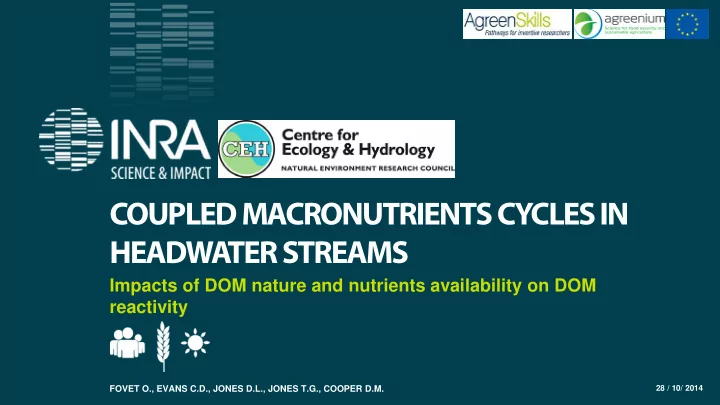

COUPLED MACRONUTRIENTS CYCLES IN HEADWATER STREAMS Impacts of DOM nature and nutrients availability on DOM reactivity 28 / 10/ 2014 FOVET O., EVANS C.D., JONES D.L., JONES T.G., COOPER D.M.
Scientific Interests Background 2004-2007 MSc Agricultural Sciences – Montpellier SupAgro, Fr 2007-2010 PhD on Water quality in Open-channels – Cemagref Montpellier, Fr Since 2011 Researcher - INRA UMR SAS – Rennes, Fr Landscape hydrology and solutes transfers using experimentation, observation and modelling approaches Looking for the dominant controls: Priming effects ? Threshold effects? Stoichiometry Biology Physical and hydrological conditions .02 FOVET O. / COUPLED MACRONUTRIENTS CYCLES IN HEADWATERS 28 / 10 / 2014
The project Overview: “Turf2Surf”: Multi-scale response of Water quality , biodiversity and Carbon sequestration to coupled Macronutrients cycling from source to sea Atmosphere-Land Land-Freshwater Freshwater Estuary Sources Sea My contribution: •Laboratory experiments based on 3 headwater types with contrasted water chemical features: Peats – Forests - Grasslands • Light-UV treatments x Nutrient additions treatments •Measuring the changes in pH, Alk, [DOC], [DTC], [N], Anions, Cations, and Absorbance .03 FOVET O. / COUPLED MACRONUTRIENTS CYCLES IN HEADWATERS 28 / 10 / 2014
Results REACTIVITY OF DISSOLVED ORGANIC MATTER IN HEADWATER STREAMS Impacts of DOM composition and nutrients availability FOVET O. (1,2,3) , EVANS C. D. (3) , JONES D.L. (4) , JONES T .G. (5) , COOPER D.M. (3) Introduction: Need to link the C-N-P macronutrients cycles in headwaters •What is DOM: A wide range of compounds from land vegetation and soil biomass as well as aquatic biomass (phytoplankton, bacteria,...) • Streams act as active pipes to export DOM from land to sea: 80% of the total C fluxes impacted ( Tranvik et al., 2009 ) : • Various processes either chemical e.g.: Photo-oxidation of photosensitive organic compounds such as peat derived DOM (Moody et al., 2013) or biological (e.g. respiration, photosynthesis) with strong interactions with inorganic nutrients (Ni, Pi) M&M: Laboratory experiments Sampling sites in Conwy catchment North Wale, UK Experimental set-up Hiraethyln : Grasslands, sheep grazing Contrasted dynamics depending on the water chemistry: 5 days recirculation = total irradiance equivalent to 1 sunny day 7.4 km2 Liverpool Wale Englan s d Wales Glasgwm: Forested Nant y Brwyn Upper : Peats Controlled UV- Light exposition 7.2 km2 1.1 km2 DOM tends to be degraded in Peat stream while it is produced in Agricultural stream Water cool bath Results: (1) All DOM is not the same 20 LIGHT Peat stream 10 Agricultural stream 5 Forested stream Peat : 18 DARK SUVA=0.052 SUVA=0.020 [DIN]=0.3 mg/l SUVA=0.023 Photochemical oxidation : 26% decrease of [DOC] LIGHT+HgCl2 [DIN]=0 mg/l 8 [DIN]=3 mg/l 4 DARK LIGHT Biological Production of DOC:+1.6 mg/l 16 LIGHT+HgCl2 DOC mg/l DOC mg/l DOC mg/l Farmland: 14 6 3 Production of DOC: 128% increase of [DOC] When adding nutrients to peat water, the system switches on DOM production 12 No photodegradation measurable 4 LIGHT 2 10 DARK LIGHT+HgCl2 Forest: Not clear (low levels of C and nutrients) 8 0 10000 20000 30000 2 0 10000 20000 30000 1 0 10000 20000 30000 Cumulative irradiance kJ/m2 Cumulative irradiance kJ/m2 Cumulative irradiance kJ/m2 General decrease of SUVA and aromaticity Results: (2) Nutrient additions enhance the production of DOC in all waters 34 22 •Addition of nutrient enhances the DOC production LIGHT Peat stream DARK Agricultural stream LIGHT Forest stream 29 DARK 18 LIGHT 12 LIGHT+N •N and P appear co-limiting LIGHT+N LIGHT+P LIGHT+P LIGHT+N+P Biological consumption of P and N, Release 24 LIGHT+P DARK+N 14 LIGHT+N+P mg DOC/l DARK due to photo-degradation? mg DOC/l LIGHT+N+P mg DOC/l DARK+N 8 DARK+N 0.1 0.4 PEAT AGRICULTURAL FOREST 19 Relative variation of [P-PO4] 0.05 Relative variation of [N-NO3] 0.2 10 0 -0.05 0 -0.2 14 4 -0.1 PEAT -0.4 6 -0.15 FOREST AGRICULTURAL -0.6 9 -0.2 -0.25 -0.8 -1 0 1 2 3 4 5 2 0 1 2 3 4 5 0 0 1 2 3 4 5 Days Days Days Discussion and Perspectives • Photo degradation of Peat derived DOM can be significant • Current understanding suggest that DOM is photo-degraded as CO 2 or partially photo-oxidized (DOC ox) ( Cory et al., 2014 ), but our results suggest that photo oxidation process may enhance new aquatic DOC biological production via inorganic nutrient release. Implications for the real stream ? On-going modelling approach • Possible sources of carbon for this production are particulate organic carbon, and mineral carbon • On-going modelling approach for estimating reaction rate as a function of inorganic nutrient and comparison with modelled residence times in the Conwy river and estuary. References Acknowledgements Cory et al., 2014. Sunlight controls water column processing of carbon in arctic freshwaters. Science 345, 925. This work benefited from the Agreenskills program me and takes part of the Turf2Surf project: “From Source to Sea”, Moody et al., 2013. The rate of loss of dissolved organic carbon (DOC) through a catchment. Journal of Hydrology , 492, 139–150. funded by the NERC Macronutrient Cycle Programme Tranvik et al., 2009. Lakes and reservoirs as regulators of carbon cycling and climate. Limnol. Oceanogr ., 54(6, part 2), 2298–2314. Contact : ophelie.fovet@rennes.inra.fr 1 INRA, UMR 1069, SAS, Rennes, France 2 AgroCampus-Ouest, UMR 1069, SAS, Rennes, France 3 Centre for Ecology and Hydrology, Bangor , UK (Hosting laboratory) 4 School of Environment Natural Resrouces and geography, Bangor University, Bangor, UK 5 School of Biological Sciences, Bangor Unviersity, Bangor, UK www.rennes.inra.fr contact: www.ceh.ac.uk/sites/bangor.html ophelie.fovet@rennes.inra.fr 0.25 0.20 2.29 3.49 [P-PO4] mg/l Apparent production 0.15 0.30 0.53 Peat (mg C/l/d) depending on nutrient 0.10 Agri concentrations 1.80 2.74 Forest 0.05 0.10 0.18 0.46 0.00 0 2 4 6 8 10 [DIN] mg/l .04 FOVET O. / COUPLED MACRONUTRIENTS CYCLES IN HEADWATERS 28 / 10 / 2014
Recommend
More recommend